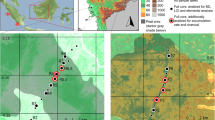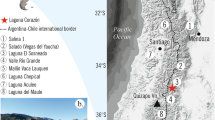Abstract
Analysis of δ18Ocellulose, δ13Corganic matter, and δ13Ccellulose at about 100 year intervals from organic matter deposited in Toronto Lake, Northwest Territories, Canada, revealed an 8000-year history of rapid, post-glacial hydrologic change at the treeline zone. Several mid-Holocene phases of enriched δ13Corg and δ13Ccell, caused by elevated lake productivity, declining [CO2(aq)], and closed basin conditions, were abruptly terminated by intervals of open hydrology recorded by sharply depleted δ18Ocell. Two of these events, at 5000 and 4500 BP, are correlated with increased total organic content and Picea mariana pollen concentration, which indicate that high levels of productivity were also accompanied by northern treeline advances. A third treeline advance at about 2500 BP is also marked by an apparent outflow event from Toronto Lake, but this was not associated with δ13Corg/cell enrichment in the sediment record because rapid and substantial lake water renewal probably prevented productivity-driven enrichment of the dissolved inorganic carbon and replenished the CO2(aq) supply to thriving phytoplankton. However, high sediment organic content during this period suggests increased productivity. Increases in the inflow:evaporation ratio at about 6500 and 3500 BP were also sufficient to cause Toronto Lake to overflow but the prevailing climate during these periods apparently did not favour appreciable northward treeline migration or changes in lake productivity.
Similar content being viewed by others
References
Anderson, P. M., P. J. Bartlein, L. B. Brubaker, K. Gajewski & J. C. Ritchie, 1991. Vegetation-pollen climate relationships for the arcto-boreal region of North American and Greenland. J. Biogeol. 18: 565–582.
Aravena, R., B. G. Warner, G. M. MacDonald & K. I. Hanf, 1992. Carbon isotope composition of lake sediments in relation to lake productivity and radiocarbon dating. Wuat. Res. 37: 333–345.
Black, R. A. & L. C. Bliss, 1980. Reproductive ecology of Picea mariana (Mill.) BSP., at treeline near Inuvik, Northwest Territories, Canada. Ecol. Mon. 50: 331–354.
Bonan, G. B., D. Pollard & S. L. Thompson, 1992. Effects of boreal forest vegetation on global climate. Nature 359: 716–718.
BOREAS Science Steering Committee, 1990. Charting the boreal forest's role in global change. EOS 72: 33–40.
Boutton, T. W., W. W. Wong, D. L. Hachey, L. S. Lee, M. P. Cabrera & P. D. Klein, 1983. Comparison of quartz and pyrex tubes for combustion of organic samples for stable carbon isotope analysis. Analyt. Chem. 55: 1832–1833.
Bryson, R. A., 1966. Air masses, streamlines, and the Boreal forest. Geog. Bull. 8: 228–269.
Bursey, G. G., T. W. D. Edwards & S. K. Frape, 1991. Water balance and geochemistry studies in a tundra watershed: District of Keewatin, Northwest Territories. In T. D. Prowse and C. S. L. Ommanney (eds.), Northern Hydrology: Selected Perspectives. NHRI Symposium No. 6, National Hydrology Research Institute, Environment Canada, Saskatoon, Saskatchewan: 17–32.
Calder, J. A. & P. L. Parker, 1973. Geochemical implications of induced changes in C13 fractionation by blue-green algae. Geochim. Cosmochim. Acta 37: 133–140.
Davis, M. B., 1989. Lags in vegetation response to greenhouse warming. Clim. Ch. 15: 75–82.
Dean, W. E., 1974. Determination of carbonate and organic matter in calcareous sediments and sedimentary rocks by loss on ignition: Comparison with other methods. J. Sed. Pet. 44: 242–248.
DeNiro, M. J. & S. Epstein, 1981. Isotopic composition of cellulose from aquatic organisms. Geochim. Cosmochim. Acta 42: 495–506.
Department of Mines and Technical Surveys, Geological Survey of Canada, 1952. Walmsley Lake, District of Mackenzie, Northwest Territories. Map 1013A. Scale: One Inch to Four Miles.
Deuser, W. G., E. T. Degens & R. R. L. Guillard, 1968. Carbon isotope relationships between plankton and sea water. Geochim. Cosmochim. Acta 32: 657–660.
Ecoregions Working Group, 1989. Ecoclimatic Regions of Canada, First Approximation. Environment Canada, Ottawa, Canada, 119 pp.
Edwards, T. W. D., 1993. Interpreting past climate from stable isotopes in continental organic matter. In P. K. Swart, K. C. Lohmann, J. McKenzie, S. Savin (eds.), Climate Chage in Continental Isotopic Records. Geophysical Monograph 78, American Geophysical Union: 333–341.
Edwards, T. W. D. & J. H. McAndrews, 1989. Paleohydrology of a Canadian Shield lake inferred from 18O in sediment cellulose. Can. J. Earth Sci. 26: 1850–1859.
Edwards, T. W. D., W. M. Buhay, R. J. Elgood & H. B. Jiang, 1994. An improved nickel-tube pyrolysis method for oxygen isotope analysis of organic matter and water. Chem. Geol. (Isot. Geo. Sect.) 114: 179–183.
Environment Canada, 1993. Canadian Climate Normals, 1961–1990: The North. Canadian Communication Group. Ottawa, Canada, 58 pp.
Epstein, S., P. Thompson & C.J. Yapp, 1977. Oxygen and hydrogen isotopic ratios in plant cellulose. Science 198: 1209–1215.
Faegri, K. & J. Iversen, 1975. Textbook of Pollen Analysis (Third Edition). Blackwell Scientific Publications, Oxford, 295 pp.
Foley, J. A., J. E. Kutzbach, M. C. Coe & S. Levis, 1994. Feedbacks between climate and boreal forests during the Holocene epoch. Nature 371: 52–54.
Gibson, J. J., T. W. D. Edwards & T. D. Prowse, 1994, Evaporation in the North: overview of quantitative studies using stable isotopes. In S. J. Cohen (ed.), Mackenzie Basin Impact Study (MBIS) Interim Report #2. Proceedings of the Sixth Biennial Meeting on Northern Climate, Yellowknife, April 1994: 138–150.
Gibson, J. J., T. W. D. Edwards, G. G. Bursey & T. D. Prowse, 1993. Estimating evaporation using stable isotopes: quantitative results and sensitivity analysis for two catchments in northern Canada. Nord. Hydrol. 24: 79–94.
Green, J. W., 1963. Wood cellulose. In R. L. Whistler (ed.), Methods in Carbohydrate Chemistry. Vol. III. Academic Press, New York: 9–20.
Hankansson, S., 1985. A review of various factors influencing the stable carbon isotope ratio of organic lake sediments by the change from glacial to post-glacial environmental conditions. Quat. Sci. Rev. 4: 135–146.
Hansen, B. C. S. & D. R. Engstrom, 1985. A comparison of numerical and qualitative methods of separating pollen of black and white spruce. Can. J. Bot. 63: 2159–2163.
Hare, F. K. & J. C. Ritchie, 1972. The boreal bioclimates. Geog. Rev. 62: 334–365.
Herczeg, A. L. & R. G. Fairbanks, 1987. Anomalous carbon isotope fractionation between atmospheric CO2 and dissolved inorganic carbon induced by intense photosynthesis. Geochim. Cosmochim. Acta 51: 895–899.
Hollander, D. J. & J. A. McKenzie, 1991. CO2 control on carbonisotope fractionation during aqueous photosynthesis: A paleo-pCO2 barometer. Geology 19: 929–932.
Houghton, J. T., G. J. Jenkins & J. J. Epraums, 1990. Climate Change: The IPCC Scientific Assessment. Cambridge University Press. 365 pp.
Larsen, C. P. S. & G. M. MacDonald, 1993. Lake morphometry, sediment mixing and the selection of sites for fine resolution palaeoecological studies. Quat. Sci. Rev. 12: 781–792.
MacCracken, M. C., A. D. Hecht, M. I. Budyko & Y. A. Izrael, 1990. Prospects for Future Climate. Lewis Publishers, Chelsea, 270 pp.
MacDonald, G. M., T. W. D. Edwards, K. A. Moser, R. Pienitz & J. P. Smol, 1993. Rapid response of treeline vegetation and lakes to past climate warming. Nature 361: 243–246.
McKenzie, J. A., 1985. Carbon isotopes and productivity in the lacustrine and marine environment. In W. Stumm (ed.), Chemical Processes in Lakes. Wiley, Toronto: 99–118.
Moser, K. A. & G. M. MacDonald, 1990. Holocene vegetation change at treeline north of Yellowknife, Northwest Territories, Canada. Quat. Res. 34: 227–239.
Schlesinger, M. E. & J. F. B. Mitchell, 1987. Climate model calculations of the equilibrium climate response to increased carbon dioxide. Rev. Geoph. 25: 760–798.
Sternberg, L. S. L., 1989. Oxygen and hydrogen isotope ratios in plant cellulose: mechanisms and applications. In P. W. Rundel, J. R. Ehleringer, K. A. Nagy (eds.), Stable Isotopes in Ecological Research, Springer-Verlag, New York: 124–141.
Sternberg, L. S. L. & M. J. DeNiro, 1983. Biogeochemical implications of the isotopic equilibrium fractionation factor between the oxygen atoms of acetone and water. Geochim. Cosmochim. Acta 47: 2271–2274.
Sternberg, L., M. J. DeNiro & J. E. Keeley, 1984. Hydrogen, oxygen, and carbon isotope ratios of cellulose from submerged aquatic Crassulacean acid metabolism and non-Crassulacean acid metabolism plants. Pl. Physiol. 76: 68–70.
Sternberg, L. S. L., M. J. DeNiro, M. E. Sloan & C. C. Black, 1986. Compensation point and isotopic characteristics of C3/C4 intermediates and hybrids in Panicum. Pl. Physiol. 80: 242–245.
Stuiver, M., 1975. Climate versus changes in 13C content of the organic component of lake sediments during the Late Quaternary. Quat. Res. 5: 251–262.
Svoboda, J. & G. H. R. Henry, 1987. Succession in marginal arctic environments. Arc. Alp. Res. 19: 373–384.
Taal, T., 1994. Evaporation studies using 18O and 2H at Pocket Lake near Yellowknife, Northwest Territories. Unpublished M.Sc. Thesis. University of Waterloo. Waterloo, Ontario, Canada, 197 pp.
Wein, R. W., 1990. Importance of wildfire to climate change hypotheses for the taiga. In J. G. Goldammer and M. J. Jenkins (eds.), Fire in Ecosystem Dynamics, SPB Publishers.
Author information
Authors and Affiliations
Rights and permissions
About this article
Cite this article
Wolfe, B.B., Edwards, T.W.D., Aravena, R. et al. Rapid Holocene hydrologic change along boreal treeline revealed by δ13C and δ18O in organic lake sediments, Northwest Territories, Canada. J Paleolimnol 15, 171–181 (1996). https://doi.org/10.1007/BF00196779
Received:
Accepted:
Issue Date:
DOI: https://doi.org/10.1007/BF00196779




